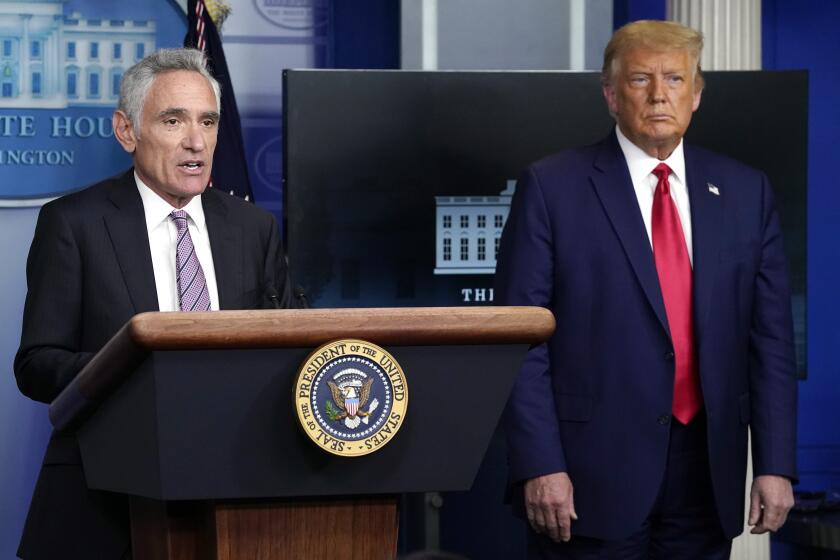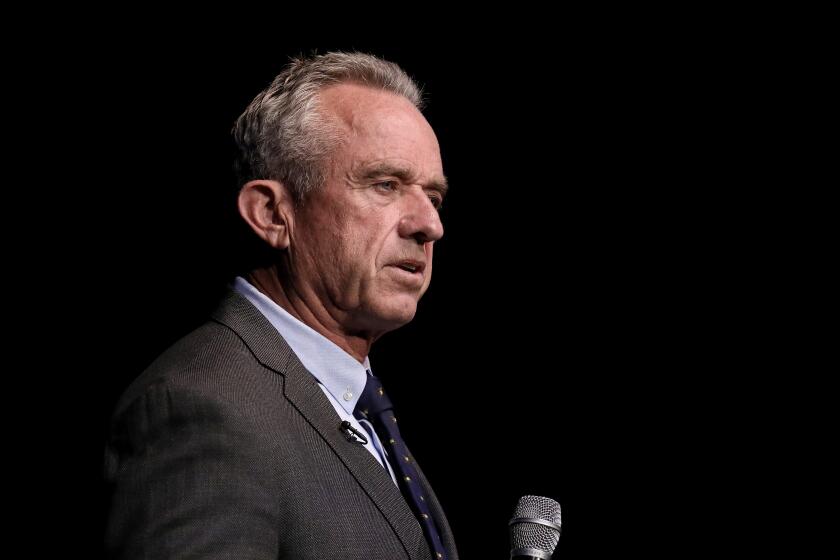Column: The Pentagon’s former top UFO hunter talks about COVID-19, Haitian pet-eaters and pseudoscience generally

- Share via
Trained as a physicist, Sean M. Kirkpatrick has spent most of his career in government, much of it as an intelligence and technology expert for various Pentagon agencies, culminating in an 18-month stint as the government’s lead investigator of UFOs.
It was in that latter position — as the first director of the Pentagon’s All-domain Anomaly Resolution Office, or AARO, that Kirkpatrick came face to face with the tide of misinformation and disinformation infecting America’s public discourse on scientific matters.
“After painstakingly assembling a team of highly talented and motivated personnel to develop a rational, systematic and science-based strategy to investigate these phenomena,” Kirkpatrick wrote in a Scientific American op-ed in January, shortly after his December retirement from AARO, he and his team were overwhelmed by a “whirlwind of tall tales, fabrication and secondhand or thirdhand retellings of the same,” producing “a social media frenzy and a significant amount of congressional and executive time and energy spent on investigating these so-called claims.”
You’re seeing the degradation of critical thinking skills and rational thought when it comes to analyzing what’s out in the world.
— Sean M. Kirkpatrick
Kirkpatrick’s observations would be familiar to scientists examining the origins of COVID, a field in which the overwhelming weight of the evidence undermines a partisan theory positing a leak from a Chinese laboratory; or the rise in anti-vaccine claims; or even those examining the false assertion by the Trump/Vance campaign of Haitian immigrants stealing and eating household pets.
All the same elements are there: the whirlwind of fabrications and the social media frenzies, the distracting effects on Congress and the White House — not to mention the complicity of the news media. “The modern media cycle drives stories faster than sound research, science and peer review time lines can validate them,” Kirkpatrick wrote.
Get the latest from Michael Hiltzik
Commentary on economics and more from a Pulitzer Prize winner.
You may occasionally receive promotional content from the Los Angeles Times.
“In my case,” Kirkpatrick told me a few days ago, “I’ve been accused of lying to the American people.”
He further revealed to the Guardian that he had experienced efforts of UFO true believers to “threaten my wife and daughter, and try to break into our online accounts — far more than I ever had as the deputy director of intelligence [of U.S. Strategic Command]. I didn’t have China and Russia trying to get on me as much as these people are.”
That would also be familiar to other scientists on the front lines of such inquiries. Scientists whose work has validated the theory that the virus causing COVID-19 reached humans via the wildlife trade in southeast Asia have been hauled before a House committee to be shrieked at by the likes of Reps. Jim Jordan (R-Ohio) and Marjorie Taylor Greene (R-Ga.), and to be accused of taking bribes and, yes, lying to the public. Vaccine advocates have been physically confronted and even assaulted by anti-vaxxers.
Kirkpatrick hasn’t participated in the debates over those issues, but he does see them as representative of the same type of doubt- and conspiracy-mongering he faced in his own territory. So let’s first examine his experience as head of AARO.
A Stanford symposium will feature purveyors of some of the most dangerous and widely debunked claims about anti-pandemic policies. Doesn’t the university have a responsibility to fight misinformation, not spread it?
The office was established in 2022 to investigate reports and earlier, of UFOs — or, to use the preferred official term, unidentified anomalous phenomena, or UAPs.
From the start, Kirkpatrick says, he was determined to conduct a rigorously empirical inquiry: “We were looking for any data to substantiate any claims that were being made to Congress or in the social media arena.”
That applied not only to pilots’ reports of objects that seemed to have displayed unusual aeronautical behavior, but a farrago of reports in the press, online, and among committed UFO believers about purportedly secret government programs to collect, examine and even attempt to reverse-engineer technology supposedly retrieved from crashed extraterrestrial UAPs.
AARO turned up “no evidence of anything extraterrestrial,” Kirkpatrick says. Of reports that the office ruled to be unexplained, the reason “came down to not having enough data to even make an assessment.” When AARO interviewed pilots, he says, “nine times out of 10,” data from their aircraft failed to substantiate their recollections, which often resulted from optical illusions or common sensor anomalies.
The agency did find indications that some sightings were related not to ETs, but to foreign surveillance activities including by China, which Kirkpatrick has said possesses technological capabilities that may match or even exceed those of the U.S. That’s plainly a national security issue, as he testified to a Senate subcommittee in April 2023, but not an interstellar one.
As for secret government programs, according to an unclassified report AARO issued in March, the agency examined every claim in the press and social media — of CIA experiments, “leaked” government documents, technology tests purportedly in the presence of “aliens,” physical examinations of extraterrestrial spacecraft, collections of extraterrestrial material in the possession of private companies, and so on.
AARO found them to be the product of mistaken overheard conversations, falsified documents, the misinterpretation of unexceptional terrestrially manufactured material as extraterrestrial artifacts. None of the people making these claims and interviewed by AARO turned out to have firsthand knowledge of these programs and incidents, but were mostly repeating what they had heard from others.
Johns Hopkins, Yale and others are offering scientists and physicians guides for addressing misinformation and disinformation. It’s an uphill battle.
“The aggregate findings of all [U.S. government] investigations to date,” the report states, “have not found even one case of UAP representing off-world technology.”
Nevertheless, these claims have been a staple of news reporting for years, even by some of most august news organizations. They have been made by witnesses paraded before congressional committees — though as Kirkpatrick noted in Scientific American, “none of the conspiracy-minded ‘whistleblowers’ in the public eye had elected to come to AARO to provide their ‘evidence’ and statement for the record despite numerous invitations.”
The source of the narrative is a small cadre of individuals associated with Las Vegas industrialist Robert Bigelow, who funded research into UAPs — as well as on paranormal phenomena — through a private organization he disbanded in 2004. Bigelow apparently persuaded the late Senate Majority Leader Harry Reid (D-Nev.) to ask the Pentagon to establish a program to safeguard the alien material that the government was allegedly hiding. (The Defense Department refused.)
Bigelow continued to press his conviction that aliens have visited Earth from outer space after 2004, including during a 2017 interview on “60 Minutes.” He didn’t reply to my request for comment, relayed via his company Bigelow Aerospace.
As with UAPs, the same names keep cropping up in the COVID origins debate. The list of promoters has barely changed since the pandemic erupted in early 2020, many of them cited misleadingly as experts in news articles promoting the lab-leak theory, which are invariably (and embarrassingly) evidence-free.
There are some distinctions between how the UAP debate and those over COVID’s origins and the safety and efficacy of vaccines have unfolded. Advocates of the lab-leak theory of COVID’s origins don’t appear to have well-heeled financial backers at their core, for example. But at the heart of that theory and the anti-vaccination movement are self-interested advocates who feed one another’s convictions.
“Some of them are naive, some like to influence power and legislation, some are in it for money, some for fame, some may even be true believers,” Kirkpatrick says. They almost never admit to error, because “they’ve made this central to their life’s purpose.” They inject their convictions into politics and the legislative process “through access to higher authorities,” to drive the Defense Department and the intelligence community “to do things and spend money.”
There’s nothing wrong with people asking the government to “definitively investigate some of these things and put some evidence on the table and show what is true and what isn’t,” he says. “Where it becomes an issue is when it is a continuous hammering of this until they get an answer that they like, even though everything uncovered to date points to the contrary.”
Measles cases are surging in Europe and Central Asia, according to the World Health Organization. Who’s responsible? The anti-vaccination movement and its leaders, such as Robert F. Kennedy Jr.
That points to “a larger problem with public opinion about scientific inquiry — science by social media versus science by scientific method,” he says. “You’re seeing the degradation of critical thinking skills and rational thought when it comes to analyzing what’s out in the world.”
When scientific data confound received beliefs, he says, “people cry ‘conspiracy,’ or ‘the data is wrong,’ or ‘scientists are making it up.’... Well, some of these scientists have been around for 30 or 40 years. If you don’t believe they know what they’re doing, then what are you going to base your decisions on in the future? Just pure belief and speculation?”
Kirkpatrick is working on another article on the topic of misinformation. “I see what I was doing on UAP and misinformation as a microcosm of many other issues that challenge the U.S. today. That is, the division across belief lines where evidence suggests a contrary opinion that conflicts with one’s own belief system or political system.”
Those conflicts can be exploited by foreign adversaries or domestic actors seeking political gains or personal fortunes. “It’s a common and increasing trend that’s worrisome from a governance perspective,” Kirkpatrick says, with a passionate edge to his voice. “How do you govern when those gaps and seams are not only being exacerbated and exploited, but are amplified through social media and media with influence over political powers in the U.S.?”
Having devoted his career to the national security, the trend leaves him concerned and appalled. “The public needs to understand how science works, and if it goes against their belief, it’s not a conspiracy,” he says.
“They need to understand that their beliefs are being exploited, either by people in the U.S. or people in other countries for gain. If the American public understood fully that they’re being taken advantage of, they address things differently. Because Americans don’t like to be taken advantage of.”
More to Read
Inside the business of entertainment
The Wide Shot brings you news, analysis and insights on everything from streaming wars to production — and what it all means for the future.
You may occasionally receive promotional content from the Los Angeles Times.














